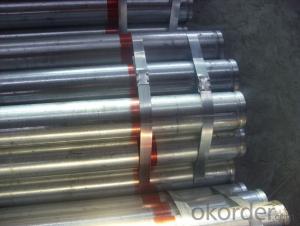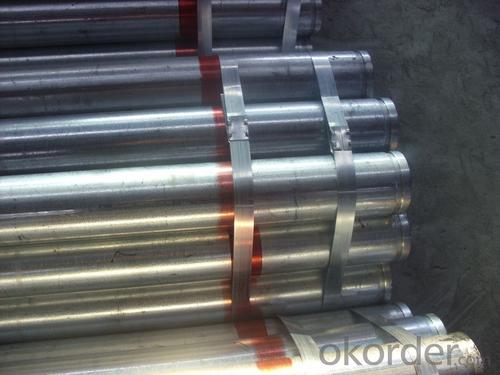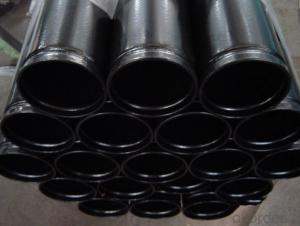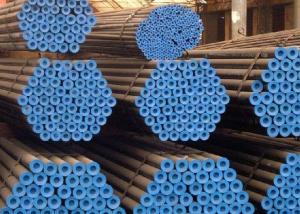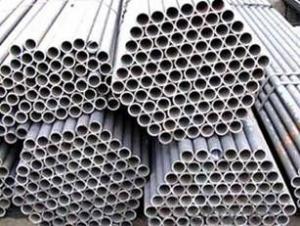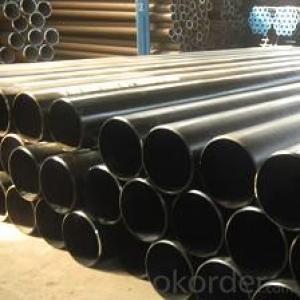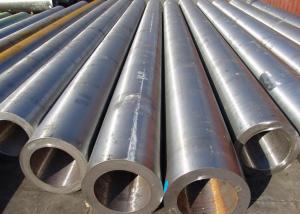seamless grooved pipe for fire fighting
- Loading Port:
- China Main Port
- Payment Terms:
- TT OR LC
- Min Order Qty:
- -
- Supply Capability:
- -
OKorder Service Pledge
OKorder Financial Service
You Might Also Like
Our company is specialized in the supply of Hot Dipped Galvanized Pipes. We supply stee pipesl with very competitive price to meet customers' needs with the satisfied service and high standard quality.
Name | galvanized pipe with the standard quality |
Material | Q195, Q215, Q235, Q345, STK500 |
Specification | O.D.: 20- 273.1MM W.T.: 0.8 - 5mm |
Length | 5.8m, 6m, 11.8m or 12m, or per the buyers demand |
Surface treatment | Oil-dip, Varnish, Passivation, Phosphating, Shot Blasting. |
Certificates | BS1387-1985, DIN2440/2441, JIS-G3444 and ASTM |
Manufacture Technique | Seamless |
Section Shape | Round |
End | A): GTC (galvanized threaded and coupling) |
Weight | Billing on the basis of theoretical weight |
Packaging Details | Export packing or negotiation |
Trade Terms | FOB/CFR/CIF |
Payment Terms | L/C T/T |
Usage | Petroleum casing pipe/etroleum cracking pipe/gas cylinder tubes/highpressure boiler tubes/ high pressure chemical fertilizer pipe, ship tube |
Delivery Time | 7-30 days OR upon the negotation |
Minimum Order Quantity | 20/50/100 MT |
Supply Ability | 1000 Ton/Month |
Inspection | Chemical Composition Inspection, Mechanical Properties Test(Tensile Strength,Yield Strength, Elongation, Flaring, Flattening, Bending, Hardness, Impact Test), Surface and Dimension Test,No-destructive Test, Hydrostatic Test. |
- Q: How are steel pipes threaded for easy installation?
- Steel pipes are threaded for easy installation by using a specialized machine called a pipe threading machine. This machine cuts precise threads onto the ends of the steel pipes, allowing them to be easily connected and tightened together using threaded fittings or couplings. This threading process ensures a secure and leak-proof connection, making installation quick and efficient.
- Q: What are the common methods of joining steel pipes?
- The common methods of joining steel pipes include welding, threading, and using mechanical couplings. Welding involves fusing the pipes together using heat, while threading involves screwing the pipes together using threads on the ends. Mechanical couplings are devices that connect the pipes together using compression or other means.
- Q: Can steel pipes be used in extremely cold temperatures?
- Yes, steel pipes can be used in extremely cold temperatures. Steel is known for its strength and durability, making it suitable for various applications, including in extreme cold weather conditions. Steel pipes have a high resistance to low temperatures and can withstand the effects of freezing temperatures without losing their structural integrity. This makes them ideal for use in industries such as oil and gas, where they are exposed to sub-zero temperatures. Additionally, steel pipes can be insulated or coated to provide further protection against the cold and prevent any potential issues, such as freezing or cracking. Overall, steel pipes are a reliable choice for use in extremely cold temperatures.
- Q: How are steel pipes used in the construction of industrial facilities?
- Steel pipes are commonly used in the construction of industrial facilities for various purposes such as transporting fluids, gases, and steam, as well as providing structural support and carrying electrical wiring. They are durable, resistant to corrosion, and can withstand high pressure and temperature, making them ideal for industrial settings.
- Q: What are the different end finishes for steel pipes?
- Different end finishes are used for steel pipes, depending on their intended use and specific requirements. Some common types of end finishes for steel pipes include: 1. Plain End: This is the most basic and widely used end finish. The pipe is cut square at both ends without any additional treatment or threading. Plain end pipes are typically used for low-pressure applications or when welding methods will be used for connection. 2. Beveled End: A beveled end finish involves cutting the pipe at an angle, usually 30 or 37.5 degrees. This makes welding easier and creates a stronger joint. Beveled end pipes are commonly used for butt-welding applications, where two pipes are aligned and welded together at the beveled ends. 3. Threaded End: In this end finish, the pipe is threaded at both ends to allow for easy connection with threaded fittings or couplings. Threaded end pipes are commonly used in plumbing and gas distribution systems, as well as for applications that require frequent disassembly and reassembly. 4. Coupled End: Coupled end finishes involve the installation of couplings or connectors at each end of the pipe. This allows for quick and easy connection of pipes without the need for additional threading or welding. Coupled end pipes are often used in oil and gas pipelines or in applications where rapid installation is required. 5. Grooved End: A grooved end finish involves cutting grooves into the pipe's ends and using mechanical couplings or fittings to join the pipes together. This type of end finish is commonly used in fire protection systems and for large-diameter pipes that require efficient assembly. 6. Flanged End: Flanged end finishes involve attaching flanges to the pipe ends. These flanges can be bolted together to create a secure and leak-proof connection. Flanged end pipes are commonly used in applications that require easy disassembly and reassembly, such as in chemical plants or refineries. It's important to consider factors such as the application, required joint strength, connection method, and compatibility with other system components when choosing an end finish for a steel pipe. Consulting a professional or referring to industry standards is recommended to ensure the correct end finish is selected for a specific application.
- Q: What are the different grades of steel pipes?
- There are several different grades of steel pipes, including carbon steel, stainless steel, and alloy steel. Each grade has its own unique properties and is used for specific applications based on factors such as strength, corrosion resistance, and temperature resistance.
- Q: How do you calculate the flow rate of water in steel pipes?
- To calculate the flow rate of water in steel pipes, you can use the equation Q = A × V, where Q represents the flow rate in cubic meters per second, A denotes the cross-sectional area of the pipe in square meters, and V represents the average velocity of the water in meters per second.
- Q: How are steel pipes used in the construction of oil-fired power plants?
- Steel pipes are primarily used in the construction of oil-fired power plants for transporting oil and gas, as well as for the construction of boilers and other high-pressure equipment. These pipes are durable, resistant to corrosion, and can withstand high temperatures and pressures, making them suitable for the harsh conditions and demands of power plant operations.
- Q: How are steel pipes used in the construction of tunnels?
- Steel pipes are commonly used in the construction of tunnels for various purposes, such as drainage systems, ventilation, and providing structural support. They are used to create efficient and durable drainage systems to manage water flow and prevent flooding in tunnels. Steel pipes are also used for ventilation systems, allowing fresh air to circulate and remove pollutants. Additionally, they can be employed to provide structural support, reinforcing the tunnel walls and ensuring stability and safety.
- Q: Can steel pipes be used for high-temperature applications?
- Yes, steel pipes can be used for high-temperature applications. Steel pipes possess excellent heat resistance properties, making them suitable for conveying fluids or gases at elevated temperatures. The high melting point and thermal conductivity of steel allow it to withstand and transfer heat effectively, making it a reliable choice for industries such as oil and gas, power generation, and chemical processing. Additionally, steel pipes can be manufactured with specific alloys or coatings to enhance their resistance to corrosion and oxidation, further increasing their suitability for high-temperature applications.
Send your message to us
seamless grooved pipe for fire fighting
- Loading Port:
- China Main Port
- Payment Terms:
- TT OR LC
- Min Order Qty:
- -
- Supply Capability:
- -
OKorder Service Pledge
OKorder Financial Service
Similar products
Hot products
Hot Searches
Related keywords
